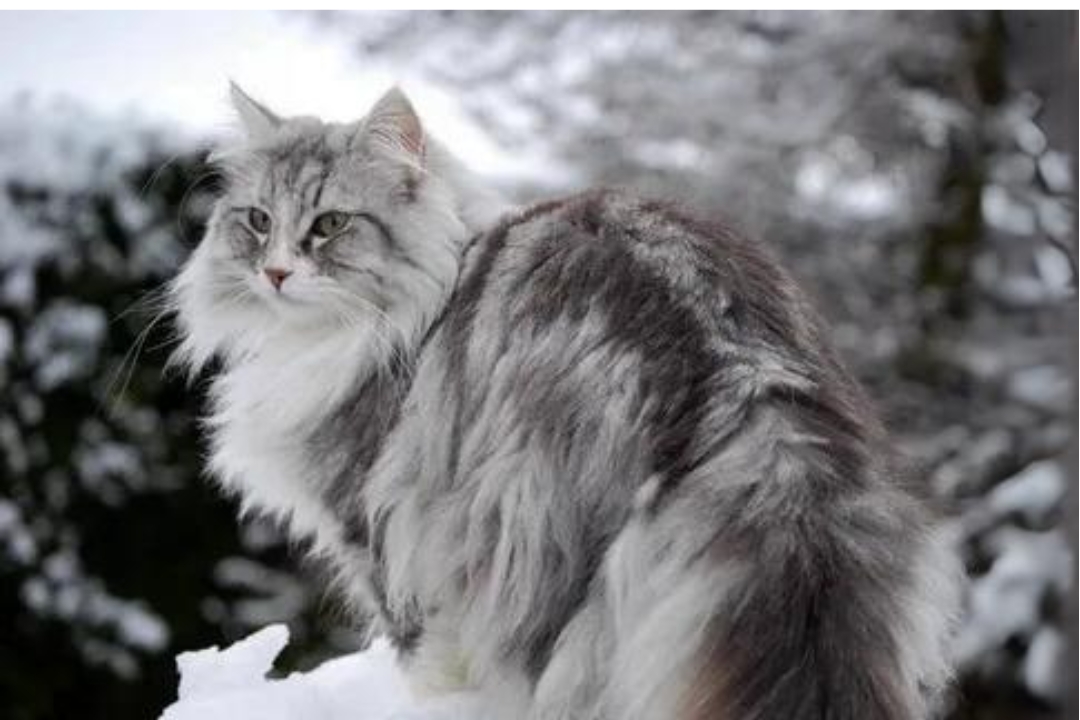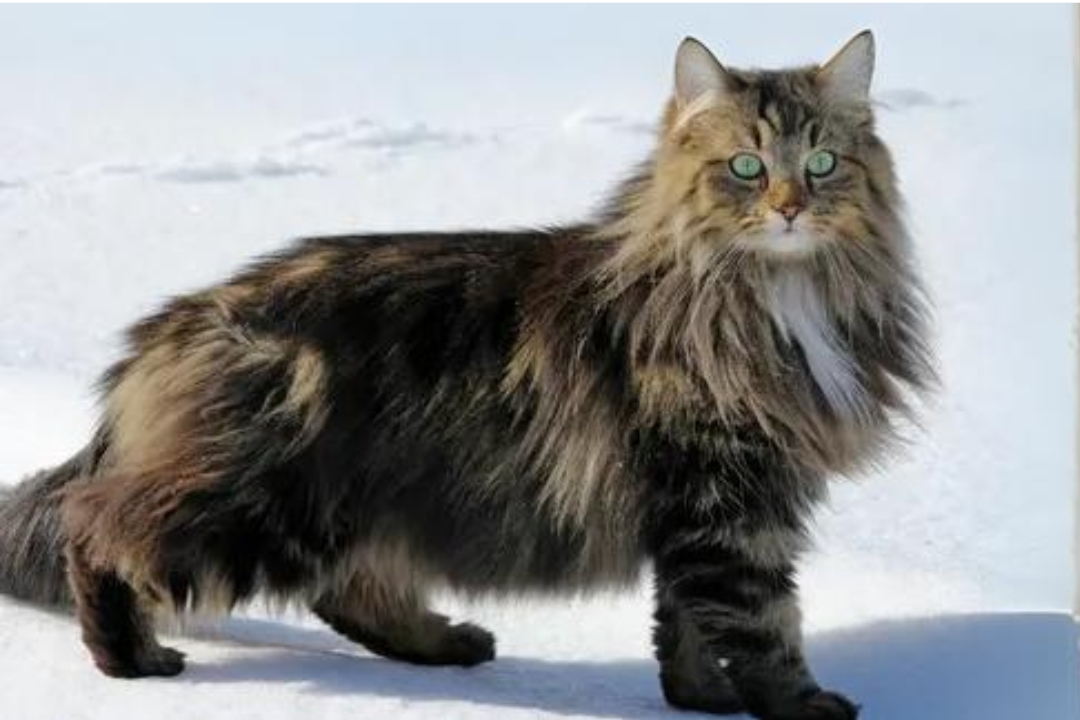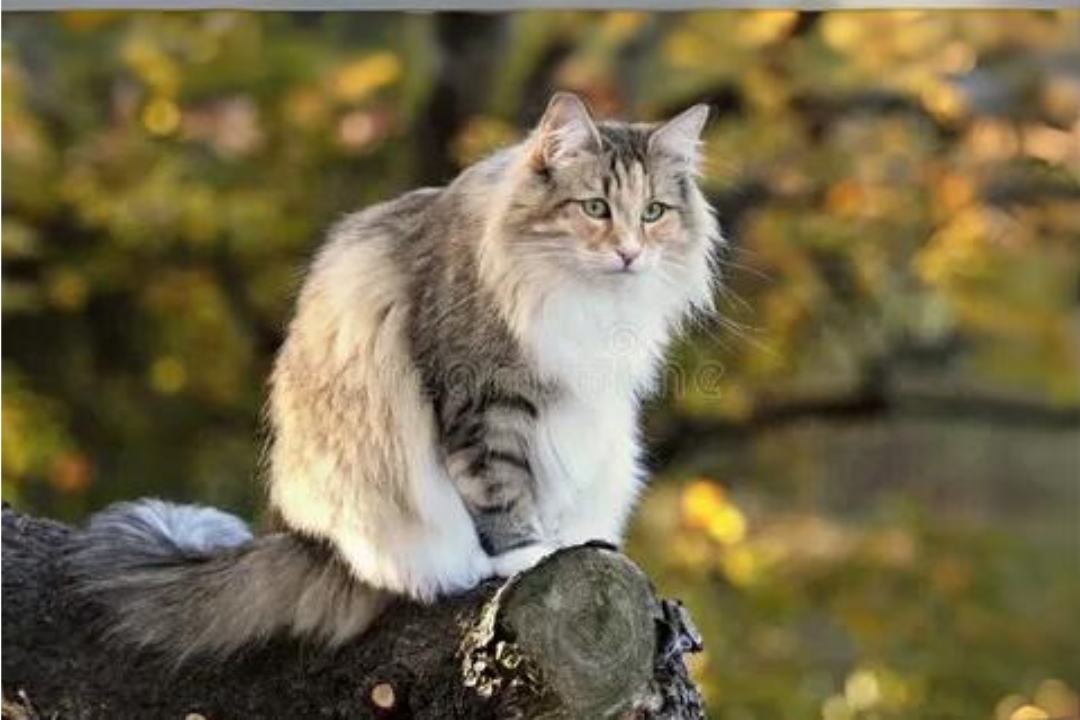The Norwegian Forest Cat: A Majestic Feline of Nordic Legend 18
History and Origins
The beginnings of the Norwegian Timberland Feline are covered in secret, entwined with legend and fables. Some accept that these felines were the associates of Viking sailors, assisting with controlling the rat populace on ships. Others recommend that they may be relatives of long-haired felines brought to Norway by Crusaders or early dealers.
The variety was nearly lost to history during The Second Great War when their numbers dwindled. Nonetheless, committed reproducing programs in Norway assisted with resuscitating and protect this one of a kind feline. The Norwegian Timberland Feline was formally acknowledged as a variety by the Fédération Internationals Cats ) in 1977, and it has since acquired fame around the world
Physical Characteristics
The Norwegian Woods Feline is a huge, solid feline with a powerful form that mirrors its survivalist starting points. Guys normally weigh between 13-22 pounds (6-10 kg), while females are marginally more modest, going from 8-18 pounds (3.5-8 kg). Their bodies are long and strong, upheld by solid legs, with the back legs being somewhat longer than the front ones, giving them a rich, marginally shifted position.
One of the variety’s most striking elements is its thick, water-repellent twofold coat, intended to shield them from the cruel Scandinavian winters. The top layer comprises of long, polished watch hairs, while the thick undercoat gives protection. This coat arrives in different varieties and examples, however dark-striped cat, white, and dark are especially normal.
The Norwegian Woods Feline’s face is another particular component. They have a three-sided molded head with a straight profile, almond-formed eyes that can go from green to gold, and enormous, tufted ears that give them a lynx-like appearance.

Personality and Temperament
Norwegian Backwoods Felines are known for their delicate and agreeable personality. In spite of their wild appearance, they are tender and partake in the organization of their human families. They are not regularly lap felines, liking to be close to their kin as opposed to on them, however they are known to follow their proprietors from one space to another.
These felines are insightful and inquisitive, characteristics that make them incredible issue solvers and energetic associates. They have an affection for climbing and will frequently be found roosted on high retires or trees, a propensity probably acquired from their progenitors who lived in timberlands. Norwegian Woods Felines are likewise known for their calm nature, speaking with delicate twitters and quavers instead of clearly whimpers.
Care and Maintenance
Really focusing on a Norwegian Timberland Feline is moderately clear, however their sumptuous coat requires customary support to forestall matting. A week by week brushing is generally adequate, however more regular prepping might be essential during shedding seasons in the spring and fall.
These felines are for the most part sound, however they can be inclined to specific hereditary circumstances, for example, hypertrophic cardiomyopathy (HCM) and glycogen capacity illness type IV (GSD IV). Customary veterinary check-ups are critical to guarantee they stay healthy.
As regular competitors, Norwegian Timberland Felines require a lot of active work. Giving them feline trees, scratching posts, and intuitive toys can assist with fulfilling their requirement for practice and mental excitement.
Historical Significance and Cultural Impact
The Norwegian Timberland Feline is profoundly imbued in Norse folklore and Scandinavian culture. Frequently alluded to in fables as the “pixie feline,” this breed is accepted to have been the motivation for the of Norse legends — an otherworldly feline fit for scaling sheer stone faces that even the Norse god Thor couldn’t lift.
Viking Impact: It’s broadly guessed that Norwegian Woodland Felines might have gone with the Vikings on their long ships, procuring their keep by controlling the rat populace ready. Their tough nature and thick coat would have made them ideal colleagues in the brutal, cold environments of Northern Europe. This hypothesis likewise lines up with the variety’s solid, free person and their affinity for investigating — attributes that reflect the Viking soul of experience.
Current Resurgence: The variety almost disappeared because of crossbreeding and the impacts of The Second Great War. Notwithstanding, the endeavors of Norwegian reproducers during the 1930s and past assumed a basic part in saving this great feline. The development of the Norwegian Woods Feline Club in 1938 denoted the start of a concentrated work to safeguard the variety. By the 1970s, reproducers prevailed with regards to settling the populace, prompting the variety’s true acknowledgment by different feline affiliations around the world.
Detailed Physical Characteristics
Coat and Prepping: The Norwegian Woodland Feline’s jacket is its delegated brilliance. While the coat is thick, it is shockingly simple to oversee contrasted with other long-haired varieties. The surface of the fur is normally sleek, giving waterproofing and insurance from the virus. The mane around the neck is especially full in winter, giving the feline a majestic, lion-like appearance. During hotter months, they shed a critical part of this fur, uncovering a sleeker, less thick coat.
Eyes and Articulation: The eyes of the Norwegian Woodland Feline are expressive and alert, frequently mirroring a sharp knowledge. Their almond shape and slight vertical slant add to the variety’s somewhat wild, yet agreeable appearance. The shade of the eyes can fluctuate, yet they are commonly green or gold, for certain felines showing striking blue eyes, particularly in white or bicolor people.
Fabricate and Construction: Past their amazing coat, the Norwegian Woodland Feline’s form is one more sign of the variety. Their tough casing serious areas of strength for and are supplemented by enormous, tufted paws, which behave like snowshoes, assisting them with strolling on snow without sinking. The tail is long and thick, serving both as an adjusting device and a warm cover during cold evenings.

Temperament and Socialization
Versatility: Norwegian Woods Felines are exceptionally versatile to different living conditions, from country farmhouses to metropolitan condos. They are autonomous naturally, yet they structure solid bonds with their families. While they may not be excessively tenacious, they are much of the time portrayed as steadfast friends who appreciate being in similar room as their human mates.
Collaborations with Different Pets: This breed for the most part coexists well with different pets, including canines and different felines. Their quiet and patient disposition makes them especially appropriate to homes with various creatures. Be that as it may, they actually hold a specific level of territoriality, a quality acquired from their wild progenitors. Legitimate socialization since early on is critical to guarantee amicable connections in multi-pet families.
Energy and Insight: Norwegian Woodland Felines are known for their knowledge and critical thinking skills. They appreciate intuitive play and can be handily prepared to get, answer orders, or even stroll on a chain. Their affection for climbing is unrivaled, and they will frequently search out the most elevated vantage point in the house. Giving them vertical spaces like feline trees or retires can assist with fulfilling their climbing senses and keep them engaged.
Health Considerations
While Norwegian Woodland Felines are for the most part hearty and sound, there are some medical problems that potential proprietors ought to know about:
Hypertrophic Cardiomyopathy (HCM): This is a typical heart condition in many feline varieties, including the Norwegian Woodland Feline. A hereditary condition prompts thickening of the heart walls, which can cause different confusions. Mindful reproducers will frequently evaluate for HCM to decrease the gamble of giving it to people in the future.
Glycogen Capacity Illness Type IV (GSD IV): This is an uncommon hereditary problem that influences how glucose is put away in the body. Felines with this condition can’t as expected utilize glycogen, prompting serious medical problems. DNA testing can assist with distinguishing transporters of this sickness.
Joint and Bone Wellbeing: Because of their enormous size, Norwegian Woods Felines might be inclined to joint issues, like hip dysplasia or joint pain, as they age. Giving them an eating regimen wealthy in omega-3 unsaturated fats and guaranteeing they keep a sound weight can assist with relieving these dangers.
The Norwegian Forest Cat in Modern Times
Today, the Norwegian Backwoods Feline is praised for its verifiable and social importance, yet in addition for its job as a caring family pet. These felines have tracked down their direction into homes all over the planet, where they keep on enchanting with their extraordinary mix of freedom and love.
Presentation and Shows: Norwegian Backwoods Felines are famous in feline shows, where their amazing size, coat, and generally appearance are judged. These occasions likewise act as a stage to teach people in general about the variety and its consideration prerequisites.
In Writing and Media: The persona of the Norwegian Backwoods Feline has prompted its appearance in different types of media, from youngsters’ books to motion pictures. They are in many cases depicted as respectable and savvy animals, mirroring their celebrated past and noble attitude.
Connection to Nature
The Norwegian Woods Feline isn’t simply a trained cat; it is an animal profoundly associated with the wild scenes of Scandinavia. These felines are regular trackers, and their impulses are finely tuned to the rhythms of the wild. Indeed, even in a homegrown setting, their ways of behaving frequently mirror their regular tendencies, making them a remarkable mix of wild and manageable.
Hunting Abilities: Norwegian Woods Felines are talented trackers, with a sharp feeling of sight, sound, and smell. In the wild, they would have depended on these capacities to get little prey like rodents and birds. This hunting ability is as yet clear in the variety today. Indeed, even indoor felines will areas of strength for show impulses, following and jumping on plays with accuracy and energy.
Abilities to climb: In the woods of Norway, these felines would have climbed trees to chase or get away from hunters, an expertise that has been gone down through ages. Their strong rear legs and enormous, tufted paws make them fantastic climbers. In a home climate, this converts into an adoration for scaling furniture, retires, and feline trees. Giving them vertical spaces to investigate is fundamental for their bliss and prosperity.
Occasional Transformations: The Norwegian Timberland Feline’s thick, twofold layered coat is a wonder of regular designing. It permits them to endure outrageous cold, snow, and wet circumstances — qualities vital for endurance in the Scandinavian wild. The external coat is water-repellent, shedding dampness and keeping the internal layer dry and warm. This transformation makes them unquestionably versatile in unforgiving environments, a component that adds to their appeal and allure.

The Norwegian Forest Cat as a Family Member
Claiming a Norwegian Backwoods Feline is a special encounter, as these felines bring a mix of freedom and warmth that is uncommon in the catlike world. They are not excessively intense yet structure solid bonds with their human families, frequently becoming faithful and adoring buddies.
Holding with People: Norwegian Backwoods Felines are known for their delicate and quiet disposition. They are tender without being tenacious, causing them ideal for families who to see the value in a feline that appreciates organization yet in addition esteems its freedom. These felines frequently pick a most loved individual in the family and will chase after them, offering calm friendship as opposed to unmistakable presentations of fondness.
Cooperation with Youngsters: Norwegian Woods Felines are for the most part understanding and open minded, making them great allies for kids. Their perky nature implies they appreciate intelligent games, and their durable form permits them to deal with a touch of crude play. In any case, it means a lot to help youngsters to regard the feline’s limits, likewise with any pet.
Transformation to Various Conditions: One of the surprising characteristics of the Norwegian Woods Feline is its flexibility. Whether in a clamoring family with kids and different pets or in a tranquil, single-individual home, these felines change well to various day to day environments. Their free nature implies they are open to investing energy alone, however they are similarly happy in a functioning, social climate.
The Role of Norwegian Forest Cats in Cat Shows
The Norwegian Backwoods Feline is a #1 in the feline show world, where its great appearance and adjusted disposition are exceptionally valued. These felines are decided on a few elements, including their size, coat quality, and generally compliance to raise principles.
Breed Norms: In feline shows, Norwegian Woodland Felines are thought about in contrast to explicit variety principles that underscore their regular, rough appearance. Passes judgment on search for a huge, strong form, a three-sided head shape, and a thick, twofold layered coat. The tail ought to be long and shaggy, and the ears ought to have tufts of fur that add to the variety’s wild, lynx-like look.
Character in the Show Ring: Notwithstanding their wild beginnings, Norwegian Woods Felines are by and large cool headed in the show ring. Their agreeable nature makes them appropriate to the buzzing about of feline shows, where they handle the consideration and movement with beauty. This disposition, joined with their striking looks, makes them reliable champs in different rivalries.
Norwegian Forest Cats in Pop Culture
The charm of the Norwegian Woodland Feline has not slipped through the cracks in mainstream society. These felines have showed up in writing, movies, and craftsmanship, frequently representing the strange and the magnificent.
In Writing: The Norwegian Woods Feline has enlivened writers and writers, who frequently utilize the variety as an image of regular magnificence and freedom. The feline’s otherworldly standing, joined with its true appeal, makes it a most loved subject for stories that mix reality with dream.
In Film and Media: While more uncommon in standard movies, the Norwegian Woods Feline’s striking appearance has gone with it a famous decision in dream classifications, where it frequently addresses the association among people and the regular world. Their presence in media assists with supporting their status as a variety that encapsulates the soul of the wild, even in a tamed setting.
Conservation and Ethical Breeding
Likewise with every single thoroughbred creature, moral rearing practices are significant to keeping up with the wellbeing and prosperity of the Norwegian Woodland Feline. Reproducers devoted to the conservation of this breed center around keeping up with hereditary variety, staying away from inbreeding, and elevating wellbeing screenings to decrease the gamble of innate infections.
Rearing Norms: Capable reproducers stick to severe principles to guarantee that Norwegian Timberland Felines are reared such that saves their regular qualities while advancing great wellbeing. This incorporates evaluating for hereditary circumstances like hypertrophic cardiomyopathy (HCM) and glycogen capacity sickness type IV (GSD IV), as well as guaranteeing that rearing felines are liberated from other inherited issues.
Reception and Salvage: While Norwegian Backwoods Felines are a pursued variety, potential proprietors ought to think about reception and salvage choices. A few Norwegian Timberland Felines, or felines with comparative characteristics, might be tracked down in covers or through breed-explicit salvage associations. Taking on a feline in need not just gives a home to a meriting creature yet additionally adds to capable pet proprietorship rehearses.

Conclusion
The Norwegian Timberland Feline is something beyond a pet; it is a living piece of history, an association with old customs, and an image of the persevering through connection among people and the normal world. Whether you are attracted to their striking appearance, their interesting history, or their caring nature, Norwegian Woodland Felines offer a special and satisfying friendship experience.
Their lofty presence, joined with their delicate and clever attitude, makes them a phenomenal expansion to any home. As a variety that has made due through hundreds of years, adjusted to evolving conditions, and kept a cozy relationship with human development, the Norwegian Woodland Feline really encapsulates the soul of the wild — tempered by the glow and love of a tamed sidekick.
FAQs About Norwegian Forest Cats
- What is the origin of the Norwegian Forest Cat?
- The Norwegian Forest Cat, known as” in Norway, is a natural breed believed to have originated in the forests of Scandinavia. These cats have a long history, possibly dating back to the Viking era, where they may have been used as ship cats to control rodents.
- What are the distinguishing features of a Norwegian Forest Cat?
- Norwegian Forest Cats are large, muscular cats with a robust build. They have a thick, water-repellent double coat, large tufted ears, a bushy tail, and almond-shaped eyes. Their coat comes in various colors and patterns, and they have a distinctive triangular head shape.
- Are Norwegian Forest Cats friendly and affectionate?
- Yes, Norwegian Forest Cats are known for their gentle and friendly nature. They form strong bonds with their human families and are affectionate without being overly demanding. They enjoy being around people and are known for their loyalty.
- How much grooming do Norwegian Forest Cats require?
- Despite their long, thick coats, Norwegian Forest Cats require moderate grooming. A weekly brushing is usually sufficient to prevent matting, but during shedding seasons (spring and fall), more frequent grooming may be needed to manage loose fur.
- Do Norwegian Forest Cats get along with other pets?
- Generally, yes. Norwegian Forest Cats are sociable and usually get along well with other pets, including dogs and other cats. Early socialization is important to ensure they are comfortable in multi-pet households.
- What is the average lifespan of a Norwegian Forest Cat?
- The average lifespan of a Norwegian Forest Cat is typically between 12 to 16 years. With proper care, regular veterinary check-ups, and a healthy diet, some may live even longer.
- Are Norwegian Forest Cats prone to any health issues?
- While generally healthy, Norwegian Forest Cats can be prone to certain genetic conditions such as hypertrophic cardiomyopathy (HCM) and glycogen storage disease type IV (GSD IV). Regular veterinary care and genetic testing can help manage and prevent these issues.
- Do Norwegian Forest Cats make good indoor pets?
- Yes, Norwegian Forest Cats can thrive as indoor pets. They are adaptable and enjoy a comfortable home environment. Providing them with plenty of vertical spaces to climb, interactive toys, and mental stimulation will help keep them happy and healthy indoors.
- Are Norwegian Forest Cats vocal?
- Norwegian Forest Cats are not particularly vocal compared to some other breeds. They communicate in soft chirps and trills rather than loud meows, which many owners find endearing.
- What kind of diet is best for a Norwegian Forest Cat?
- Norwegian Forest Cats should be fed a balanced diet that meets their nutritional needs. High-quality cat food rich in protein, with controlled levels of fat, is ideal. It’s important to monitor their weight, as they are a large breed and can be prone to obesity if overfed.
- How active are Norwegian Forest Cats?
- Norwegian Forest Cats are naturally active and enjoy climbing, exploring, and playing. They are athletic and need regular physical activity to maintain their health. Providing them with climbing structures and engaging toys is essential.
- Can Norwegian Forest Cats be left alone for long periods?
- While they are independent cats, Norwegian Forest Cats still require companionship and mental stimulation. They can be left alone for moderate periods, but it’s important to ensure they have plenty of toys, scratching posts, and a comfortable environment to keep them occupied.
- How big do Norwegian Forest Cats get?
- Norwegian Forest Cats are a large breed. Males typically weigh between 13-22 pounds (6-10 kg), while females are slightly smaller, ranging from 8-18 pounds (3.5-8 kg). They have a strong, muscular build and a long, sturdy body.
- Do Norwegian Forest Cats enjoy being outdoors?
- Norwegian Forest Cats have a natural affinity for the outdoors due to their heritage. If you have a safe, enclosed outdoor space, they will likely enjoy exploring it. However, if they are primarily indoor cats, it’s important to ensure they have plenty of stimulation to keep them happy.
- Where can I adopt or purchase a Norwegian Forest Cat?
- Norwegian Forest Cats can be adopted from breed-specific rescues, shelters, or purchased from reputable breeders. If purchasing from a breeder, ensure they follow ethical breeding practices and can provide health clearances for their cats.
